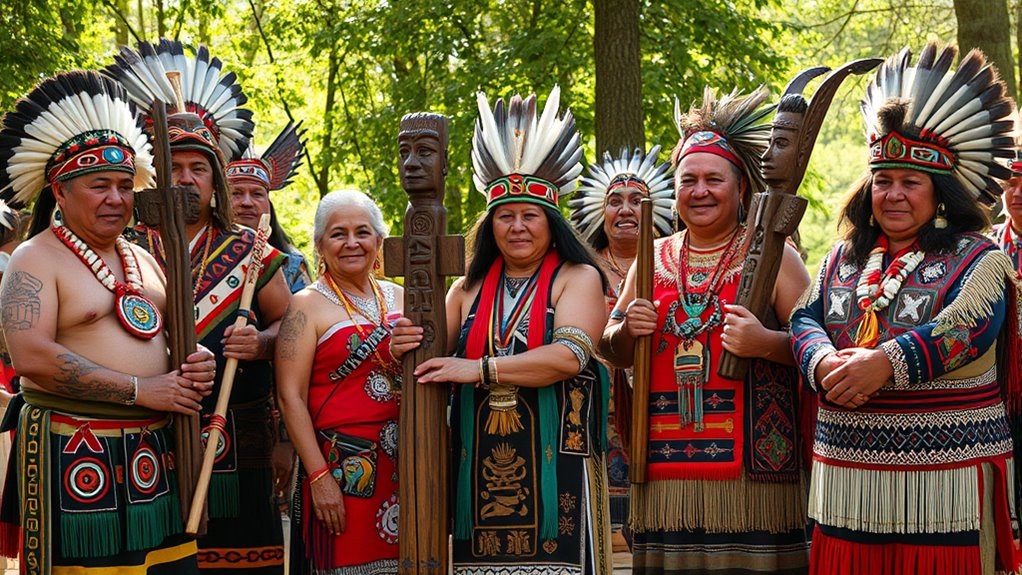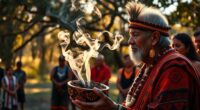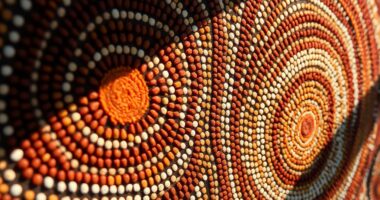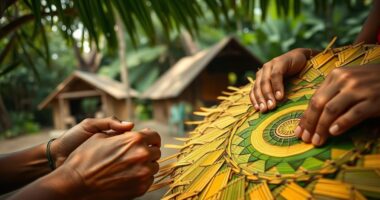Kinship systems help you understand how social roles, identities, and relationships are organized within a community. They use symbols like totems to link individuals to nature or ancestors, while skin names reveal social status or lineage. These elements define roles like guardians or elders and foster social cohesion. By exploring these elements, you’ll see how kinship shapes traditions, responsibilities, and group identity—continuing reveals even more about how these systems reinforce community bonds.
Key Takeaways
- Kinship systems categorize relationships and define social roles, guiding interactions and responsibilities within communities.
- Totems represent group identity, linking individuals to nature or ancestors, fostering social cohesion.
- Skin names indicate social status, lineage, or societal roles, reinforcing traditional cultural values.
- Kinship terminology specifies familial and social relationships, shaping social expectations and obligations.
- These systems extend beyond biology, organizing social life, maintaining traditions, and shaping individual and collective identity.

Have you ever wondered how different societies define family and relationships? It’s fascinating to see how kinship systems shape social life and identity, often through specific roles, symbols, and terminology. One key aspect is clan membership, which connects individuals to a larger kin group that provides a sense of belonging, shared history, and social obligations. When you belong to a clan, your identity isn’t just personal; it’s intertwined with a collective history and responsibilities. These clans often have unique totems—symbols or animals representing the group—that reinforce your connection to your ancestors and territory. Clan membership isn’t just about lineage; it’s about actively participating in rituals, ceremonies, and social duties that uphold your group’s integrity. Understanding kinship systems also involves recognizing how these social bonds influence leadership and authority within communities.
Understanding kinship terminology is also vital because it reveals how societies categorize relationships. Different languages and cultures have specific terms for relatives—like mother, father, cousin, or aunt—that reflect social roles and expectations. In some cultures, these terms extend beyond immediate family to include broader kin networks, emphasizing community interconnectedness. For example, a single kinship term might encompass what others see as separate relations, highlighting the social importance of those bonds. By learning these terms, you can better grasp how people perceive and prioritize family ties, obligations, and status. It’s not just about biology; it’s about the social fabric woven through language.
Kinship terms reveal how societies weave social bonds beyond biology.
In many societies, kinship terminology also helps define social roles and responsibilities. For instance, certain terms might designate someone as a guardian, elder, or leader within the family or community, guiding how you interact and cooperate. These roles often come with specific expectations—respect, support, or authority—that maintain social order. As you navigate these systems, you realize that kinship isn’t only about bloodlines but also about social bonds that structure everyday life. It influences marriage choices, inheritance, and community participation, ensuring that everyone understands their place within the larger network.
Moreover, kinship systems often include totems and skin names, which add layers of identity and social meaning. Totems serve as symbols of group identity, connecting individuals to nature or ancestral spirits. Skin names, on the other hand, can denote social status, lineage, or specific roles within the society, reinforcing social cohesion. These elements help individuals see themselves as part of a larger whole, emphasizing collective identity over individualism. Understanding these systems can also foster cultural intelligence, helping outsiders appreciate the depth and diversity of social organization. By understanding these systems, you gain insight into how societies organize themselves, maintain traditions, and transmit values across generations. Ultimately, kinship systems are more than just family trees—they’re dynamic frameworks that shape social life, identity, and cultural continuity.
Frequently Asked Questions
How Do Kinship Systems Influence Modern Legal Inheritance Laws?
You might not realize it, but kinship systems still shape modern inheritance customs and legal family structures. They influence how laws determine who inherits property, often prioritizing blood relatives and defined family roles. These systems help establish clear legal hierarchies, ensuring assets pass smoothly. By understanding kinship rules, you can better grasp why inheritance laws vary across cultures and how they reflect societal values around family and kinship ties.
What Role Do Totems Play in Contemporary Environmental Conservation Efforts?
You might not realize it, but totems hold the power to revolutionize environmental conservation today. They embody indigenous ecology and cultural symbolism, inspiring communities to protect sacred animals and nature. By honoring totems, you connect deeply with cultural traditions that promote sustainable practices and respect for the environment. This ancient wisdom fuels modern efforts, turning cultural symbols into powerful tools to preserve ecosystems and foster ecological stewardship.
Are Skin Names Unique to Specific Cultures or Universal Across Societies?
Skin names are unique to specific cultures, serving as essential parts of cultural identity and social cohesion. You’ll find they vary widely among societies, reflecting distinct traditions and social roles. These names help maintain cultural continuity, reinforce community bonds, and distinguish groups within a society. By understanding their diversity, you see how skin names contribute to preserving cultural heritage and fostering a sense of belonging across different communities.
How Do Kinship Systems Adapt to Urbanization and Globalization?
It’s no coincidence that kinship systems evolve with urbanization and globalization, shaping your social roles and relationships. You’ll find urban adaptation prompts flexibility, blending traditional kinship ties with modern social networks. This social transformation helps communities maintain identity while embracing change. As societies become more interconnected, kinship systems adapt, reflecting cultural diversity and fostering new forms of kinship beyond rural or indigenous contexts, enriching your social fabric in dynamic ways.
Can Kinship Terminology Change Over Generations Within the Same Community?
Yes, kinship terminology can change over generations within your community. As cultural identity evolves and social hierarchy shifts, new terms may emerge, and old ones fade. You might notice younger generations adopting different kinship words that reflect modern relationships or societal values. These changes help keep your community’s kinship system relevant, fostering a sense of identity and adapting to new social realities while preserving core cultural meanings.
Conclusion
Understanding kinship systems reveals that over 80% of societies worldwide organize social roles through totems, skin names, and kinship terms. You now see how these systems shape identity, community bonds, and social responsibilities. Recognizing these patterns helps you appreciate cultural diversity and the ways people connect across generations. So, next time you meet someone from a different society, remember these unique kinship ties that hold communities together in fascinating ways.









